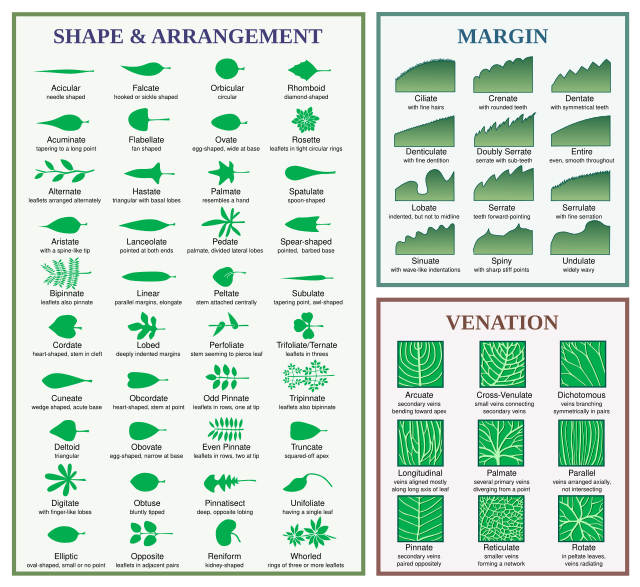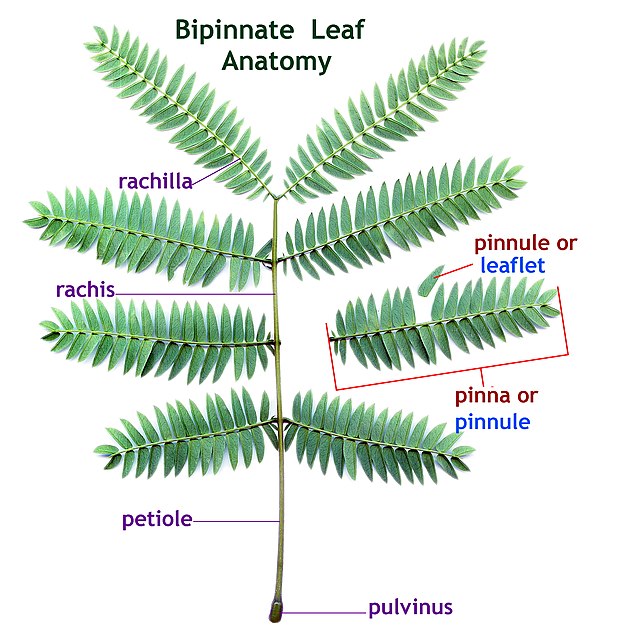Top Qs
Timeline
Chat
Perspective
Glossary of leaf morphology
From Wikipedia, the free encyclopedia
Remove ads
Remove ads
The following terms are used to describe leaf morphology in the description and taxonomy of plants. Leaves may be simple (that is, the leaf blade or 'lamina' is undivided) or compound (that is, the leaf blade is divided into two or more leaflets).[1] The edge of the leaf may be regular or irregular, and may be smooth or have hair, bristles, or spines. For more terms describing other aspects of leaves besides their overall morphology see the leaf article.

The terms listed here all are supported by technical and professional usage, but they cannot be represented as mandatory or undebatable; readers must use their judgement. Authors often use terms arbitrarily, or coin them to taste, possibly in ignorance of established terms, and it is not always clear whether because of ignorance, or personal preference, or because usages change with time or context, or because of variation between specimens, even specimens from the same plant.[citation needed] For example, whether to call leaves on the same tree "acuminate", "lanceolate", or "linear" could depend on individual judgement, or which part of the tree one collected them from. The same cautions might apply to "caudate", "cuspidate", and "mucronate", or to "crenate", "dentate", and "serrate".
Another problem is to establish definitions that meet all cases or satisfy all authorities and readers. For example, it seems altogether reasonable to define a mucro as "a small sharp point as a continuation of the midrib", but it may not be clear how small is small enough, how sharp is sharp enough, how hard the point must be, and what to call the point when one cannot tell whether the leaf has a midrib at all. Various authors or field workers might come to incompatible conclusions, or might try to compromise by qualifying terms so vaguely that a description of a particular plant practically loses its value.
Use of these terms is not restricted to leaves, but may be applied to morphology of other parts of plants, e.g. bracts, bracteoles, stipules, sepals, petals, carpels or scales. Some of these terms are also used for similar-looking anatomical features on animals.
Remove ads
Leaf structure
Summarize
Perspective
Leaves of most plants include a flat structure called the blade or lamina supported by a network of veins, a petiole and a leaf base;[1] but not all leaves are flat, some are cylindrical.[citation needed] Leaves may be simple, with a single leaf blade, or compound, with several leaflets. Compound leaves may be pinnate with pinnae (leaflets) on both sides of a rachis (axis), or may be palmate with multiple leaflets arising from a single point.[1] Leaf structure is described by several terms that include:


Remove ads
Leaf and leaflet shapes
Summarize
Perspective
Being one of the more visible features, leaf shape is commonly used for plant identification. Similar terms are used for other plant parts, such as petals, tepals, and bracts.


Remove ads
Edge
Leaf margins (edges) are frequently used in visual plant identification because they are usually consistent within a species or group of species, and are an easy characteristic to observe. Edge and margin are interchangeable in the sense that they both refer to the outside perimeter of a leaf.
Leaf folding
Leaves may also be folded, sculpted or rolled in various ways. If the leaves are initially folded in the bud, but later unrolls it is called vernation, ptyxis is the folding of an individual leaf in a bud.
Remove ads
Latin descriptions
The Latin word for 'leaf', folium, is neuter. In descriptions of a single leaf, the neuter singular ending of the adjective is used, e.g. folium lanceolatum 'lanceolate leaf', folium lineare 'linear leaf'. In descriptions of multiple leaves, the neuter plural is used, e.g. folia linearia 'linear leaves'. Descriptions commonly refer to the plant using the ablative singular or plural, e.g. foliis ovatis 'with ovate leaves'.[8]
Remove ads
See also
- Glossary of botanical terms
- Glossary of plant morphology
- Cladophylls are leaf-like petioles
- Leaf size
- Sinus
- Leaflet (botany) and Rachis
- Petiole (botany) and Plant stem
- Phylloclades are flattened stems that resemble leaves
- Pinnation
- Plant morphology
- Taxonomy (biology)
References
Bibliography
External links
Wikiwand - on
Seamless Wikipedia browsing. On steroids.
Remove ads

































































